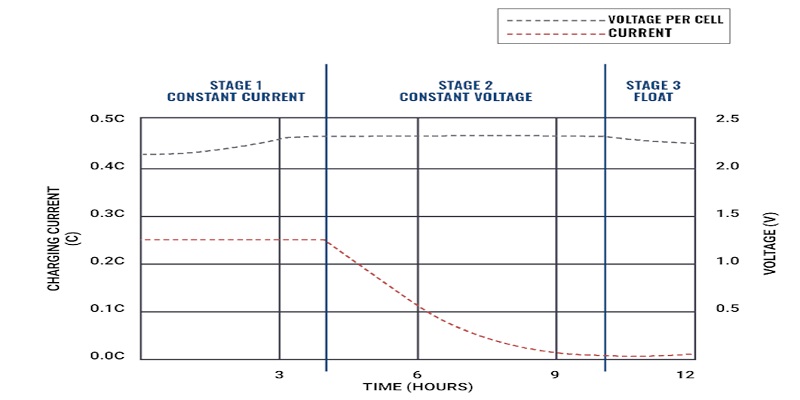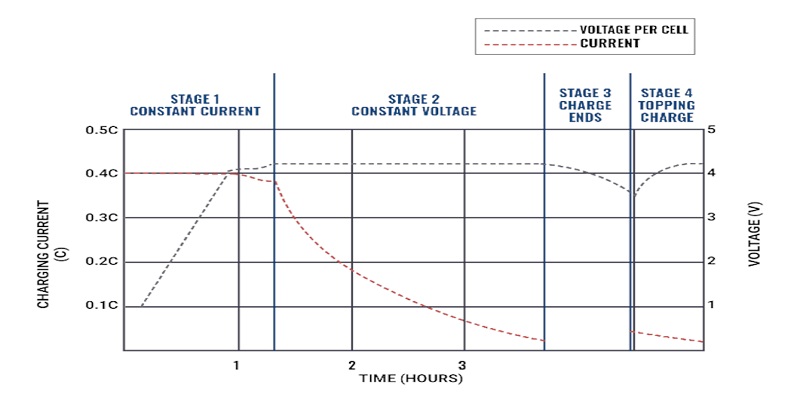If you've recently purchased or are researching
lithium iron phosphate batteries, you know they provide more cycles , an even distribution of power delivery , and weigh less than a comparable
sealed lead acid (SLA ) battery . Did you know they can also charge four times faster than SLA? But exactly how do you charge a lithium battery, anyway?
EverExceed recommends you select a charger designed for the chemistry of your battery. This means we recommend using a lithium charger when charging lithium batteries.
CAN A LEAD ACID CHARGER CHARGE A LITHIUM BATTERY?
There are many similarities in the charging profiles of SLA and lithium. However, extra caution should be exercised when using SLA chargers to charge lithium batteries as they can damage, under charge, or reduce the capacity of the lithium battery over time. There are many differences when comparing lithium and SLA batteries charging.
SEALED LEAD ACID (SLA) BATTERY CHARGING PROFILE
Let’s go back to the basics of how to charge a sealed lead acid battery. The most common charging method is a three -stage approach the initial charge (constant current), the saturation topping charge (constant voltage), and the float charge.

In Stage 1, as shown above, the current is limited to avoid damage to the battery. The rate of change in voltage continually changes during Stage 1 eventually beginning to plateau when the full charge voltage limit is approached. The constant current / Stage 1 portion of the charge is crucial before moving onto the next stage. Stage 1 charging is typically done at 10 % -30 % (0.1C to 0.3C) current of the capacity rating of the battery or less.
Stage 2, constant voltage, begins when the voltage reaches the voltage limit (14.1-14.4)V for fast charging SLA batteries). During this stage, the current draw gradually decreases as the topping charge of the battery continues. This stage terminates when the current falls below 5% of the battery's rated capacity the last stage, the float charge, is necessary to keep the battery from self -discharging and losing capacity.
If the battery is being used in a standby application, the float charge is necessary to ensure the battery is at full capacity when the battery is called upon to discharge. In an application where the battery is in storage, float charging keeps the SLA battery at 100 % State of Charge (SOC), which is necessary to prevent sulfating of the battery that therefore prevents damage to the plates of the battery.
LIFEPO4 BATTERY CHARGING PROFILE
A LiFePO4 battery uses the same constant current and constant voltage stages as the SLA battery. Even though these two stages are similar and perform the same function, the advantage of the LiFePO4 battery is that the rate of charge can be much higher, making the charge time much faster.
Stage 1 battery charging is typically done at 20 % -100 % (0.2C) current of the capacity rating of the battery. Stage 1 of the SLA chart above takes four hours to complete. The Stage 1 of a lithium battery can take as little as one hour to complete, making a lithium battery available for use four times faster than SLA.
Stage 2 is necessary in both chemistries to bring the battery to 100 % SOC. The SLA battery takes 7 hours to complete Stage 2, whereas the lithium battery can take as little as 15 minutes. Overall, the lithium battery charges in less than 5 hours, and the SLA battery typically takes more than 12 hours. In cyclic applications, the charge time is very critical. A lithium battery can be charged and discharged several times a day, whereas a lead acid battery can only be fully cycled once a day.
Where they become different in charging profiles is Stage 3. A lithium battery does not need a float charge like lead acid. In long -term storage applications a lithium battery can be maintained with a full cycle (charged and discharged) once in every 6 - 12 months up to 100% SOC. Before storage, should fully charge the battery. Before transportation, charging up to 30~70% SOC is for safety.
In standby applications, since the self -discharge rate of lithium is so low; the lithium battery will deliver close to full capacity even if it has not been charged for 6 - 12 months. For longer periods of time, a charge system that provides a topping charge based on voltage is recommended.


